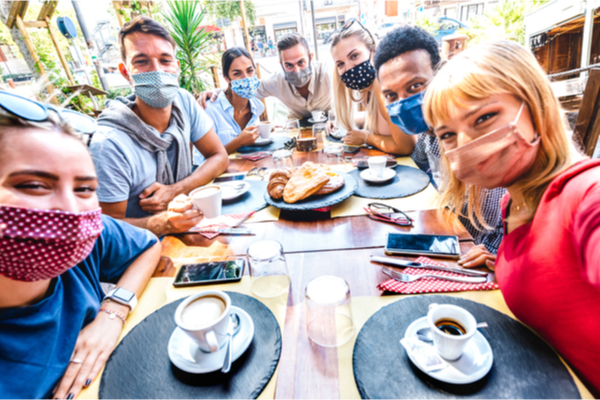With the holidays fast approaching, party season is just around the corner. But as COVID-19 cases and hospitalizations rise across the US – America just had the dubious distinction of hitting 100,000 new cases TWO days IN A ROW – the director of the Centers for Disease Control and Prevention (CDC) just warned about a worrisome source of infection spread: small gatherings, especially in household settings.
CNN reports that in a call with America’s governors last week, Dr. Robert Refield MD said, “In the public square, we’re seeing a higher degree of vigilance and mitigation steps in many jurisdictions,” describing small household gatherings as “the increasing threat,” adding, “particularly with Thanksgiving coming up, we think it’s really important to stress the vigilance of these continued mitigation steps in the household setting.”
What is a small gathering, exactly?
Though Dr. Redfield specifically warned against small gatherings, the CDC hasn’t put a specific number to “small.” Nor has it put a limit on, or recommended, a set number of guests for gatherings that would be considered safe or low-risk. However, the CDC recently issued guidance to help keep people safe while socializing during the holidays, and the advice applies to casual meetups of any kind at any time of the year.
Here are the CDC’s guidelines on social gatherings during Covid:
Before you host or attend a gathering, it’s important to assess the risks. First of all, indoor gatherings generally pose more risk than outdoor ones. And indoor gatherings with poor ventilation—such as a space with no windows, or closed doors—put you at a higher risk than those with good ventilation. Shunling Tsang MD, MPH, medical director for ambulatory quality and vice chair of the department of family medicine at Riverside University Health System in California, advises avoiding indoor gatherings altogether. “If there is a need for a small gathering, it should be held outdoors with social distancing, [and] strict adherence to mask wearing and to local and state public health guidelines,” Dr. Tsang said in an interview with Health magazine. “Indoor gatherings can pose additional challenges with air circulation and ability to socially distance, so it is best to avoid these altogether if possible.”
Also crucial is the duration of the gathering. Basically, the more time you spend with other people, the greater the risk of contracting COVID-19. So shorter gatherings, like inviting a few friends over for cover or a drink, are optimal over longer ones, such as dinner parties.
The CDC also warns that gatherings with people traveling from different places are riskier than those with people who live in the same area. The levels of COVID-19 cases and community spread in the location of the gathering matter as well. “If you live in an area with a high level of community transmission (looking at the county’s case rate and positivity rate), there is a higher risk of COVID-19 spread during gatherings,” Dr. Tsang notes.
Another important consideration is how guests have been behaving in the past before getting together now. Have they been adhering to social distancing guidelines? Have they been wearing masks in public places and washing their hands regularly? If you don’t think they have—or they come out and tell you they don’t usually mask up—it’s probably best that you don’t get close.
Who should avoid small gatherings altogether?
If any guests are sick or known to have active COVID-19 infection, attending group gatherings shouldn’t even be an option, Dr. Tsang says. Those individuals should be in quarantine or isolation.
The CDC also advises against hosting or attending any in-person gatherings if you or anyone in your household has been diagnosed with COVID-19 and hasn’t met the criteria for when it is safe to be around others. Here’s a refresher: It’s been at least 10 days since symptoms first appeared, you’ve had 24 hours with no fever without the use of fever-reducing medications, and other symptoms of COVID-19 are improving.
You should also stay away from gatherings if you have symptoms of COVID-19, are waiting for coronavirus test results, may have been exposed to someone with the virus in the last 14 days, or are at increased risk of severe illness from COVID-19 (for example, you are immunosuppressed or in another high-risk group).
What kind of gatherings are the safest?
Nobody wants to cut themselves off from their friends and family any more than they have to. So what’s the answer? While COVID-19 cases and hospitalizations are on the rise throughout the country, Dr. Tsang explains that the ideal scenario is a virtual gathering—such as over Zoom, Skype, or Google Hangout—even if you don’t have any symptoms. “A virtual gathering will provide the safest option for everyone involved,” she says.
Remember to follow the basics
And finally, whenever you’re attending any gathering, or just going through your day-to-day activities, remember to follow the basic CDC guidelines for infection-preventing behaviors: mask wearing, social distancing, and hand washing – you know the score by now – to help reduce the spread of infection.
—
Photo Credit: View Apart / Shutterstock.com
